Marketing Essentials Report: Marketing Concepts and Process Overview
VerifiedAdded on 2021/08/23
|13
|4424
|24
Report
AI Summary
This report provides a comprehensive overview of marketing essentials, beginning with the core definition of marketing as creating, communicating, and delivering value to target markets. It explores various marketing concepts, including production, product, selling, and marketing concepts, emphasizing the importance of understanding and meeting customer needs. The report then delves into the marketing process, detailing strategic marketing analysis encompassing market segmentation, niche identification, and positioning strategies. Furthermore, it examines marketing-mix planning, focusing on product development, packaging, branding, pricing, and service marketing. The report highlights the dynamic nature of product life cycles, the significance of customer input in product design, and the impact of pricing strategies on perceived product quality and market share. Overall, the report provides a solid foundation in marketing principles and practices.
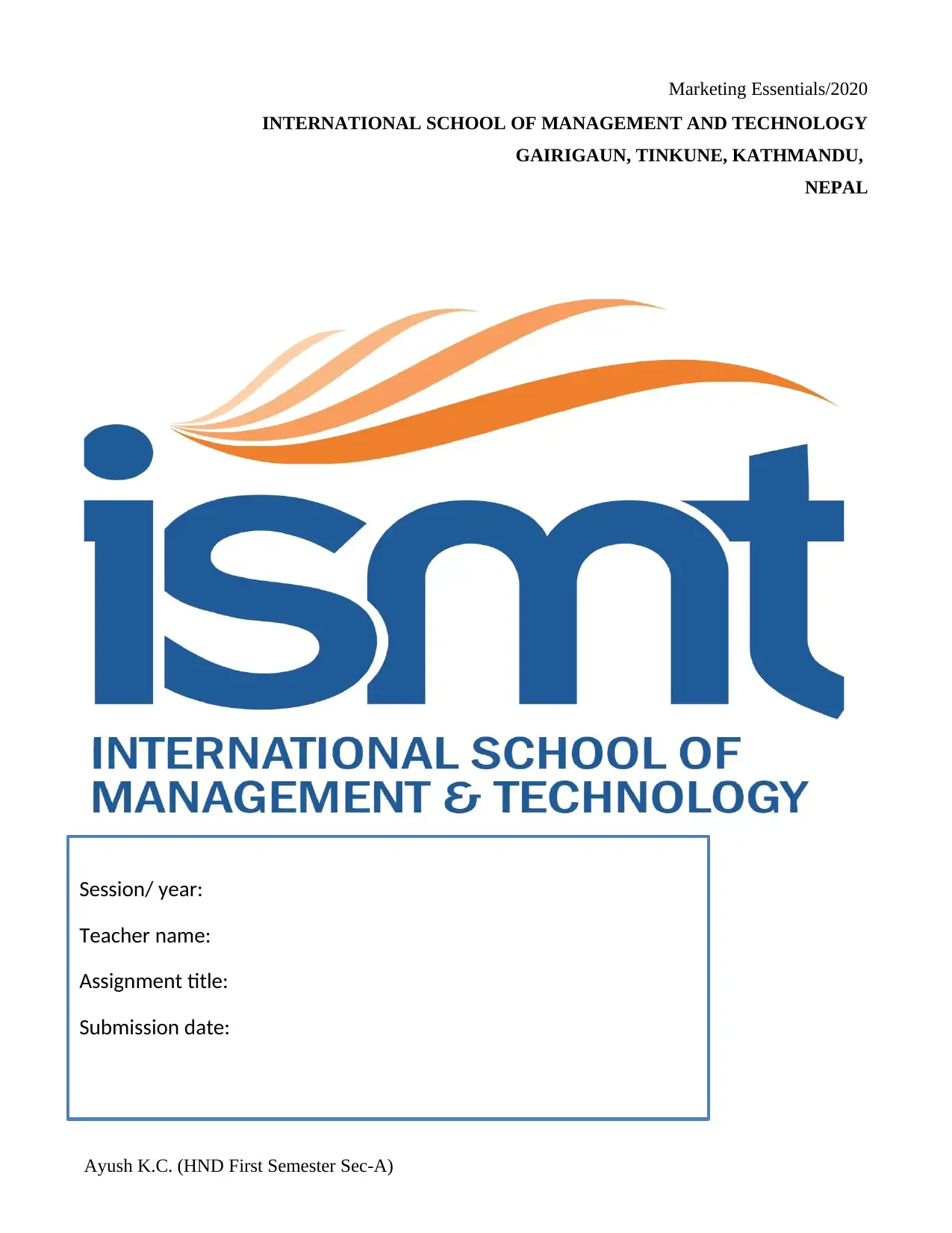
Marketing Essentials/2020
INTERNATIONAL SCHOOL OF MANAGEMENT AND TECHNOLOGY
GAIRIGAUN, TINKUNE, KATHMANDU,
NEPAL
Ayush K.C. (HND First Semester Sec-A)
Session/ year:
Teacher name:
Assignment title:
Submission date:
INTERNATIONAL SCHOOL OF MANAGEMENT AND TECHNOLOGY
GAIRIGAUN, TINKUNE, KATHMANDU,
NEPAL
Ayush K.C. (HND First Semester Sec-A)
Session/ year:
Teacher name:
Assignment title:
Submission date:
Paraphrase This Document
Need a fresh take? Get an instant paraphrase of this document with our AI Paraphraser
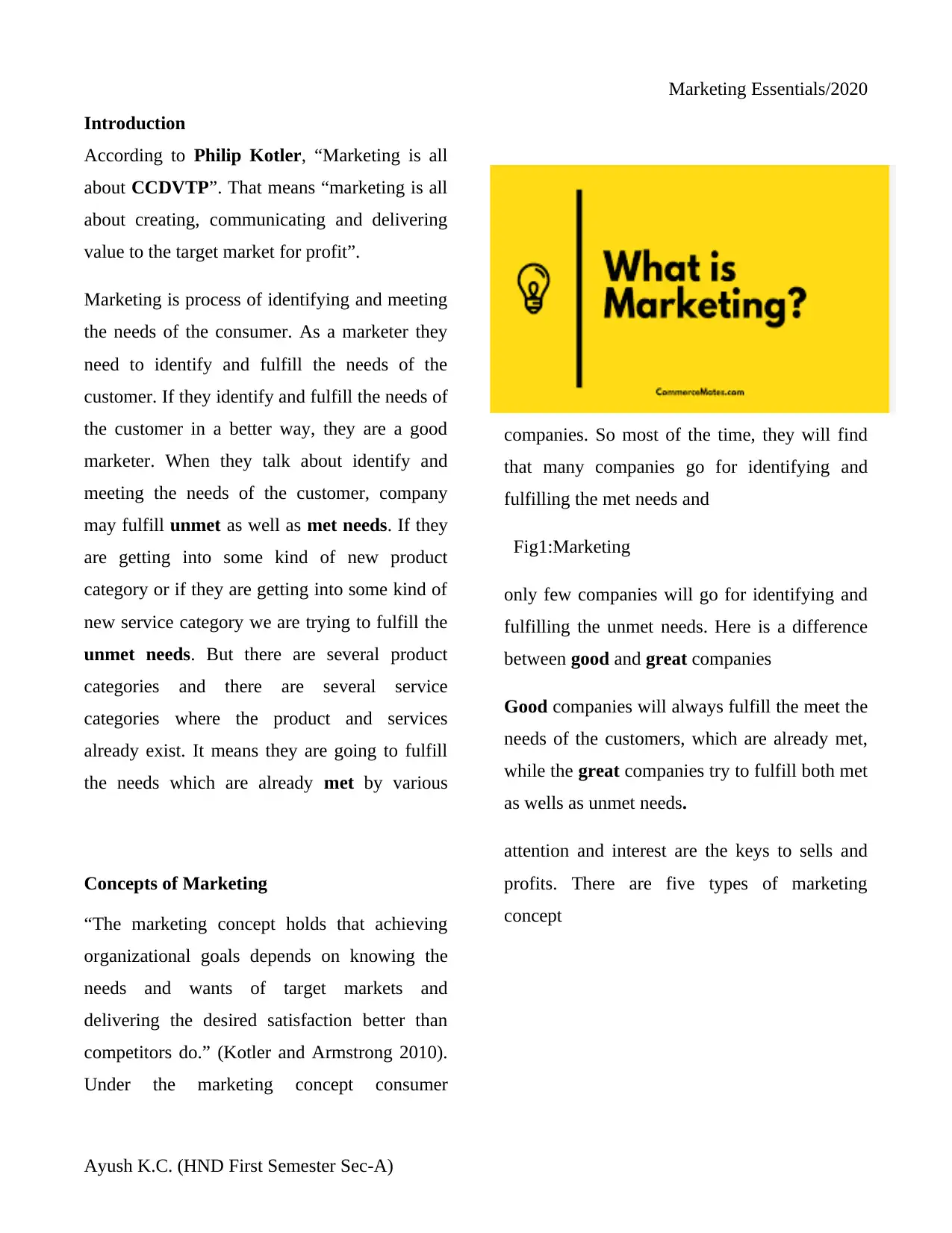
Marketing Essentials/2020
Introduction
According to Philip Kotler, “Marketing is all
about CCDVTP”. That means “marketing is all
about creating, communicating and delivering
value to the target market for profit”.
Marketing is process of identifying and meeting
the needs of the consumer. As a marketer they
need to identify and fulfill the needs of the
customer. If they identify and fulfill the needs of
the customer in a better way, they are a good
marketer. When they talk about identify and
meeting the needs of the customer, company
may fulfill unmet as well as met needs. If they
are getting into some kind of new product
category or if they are getting into some kind of
new service category we are trying to fulfill the
unmet needs. But there are several product
categories and there are several service
categories where the product and services
already exist. It means they are going to fulfill
the needs which are already met by various
companies. So most of the time, they will find
that many companies go for identifying and
fulfilling the met needs and
Fig1:Marketing
only few companies will go for identifying and
fulfilling the unmet needs. Here is a difference
between good and great companies
Good companies will always fulfill the meet the
needs of the customers, which are already met,
while the great companies try to fulfill both met
as wells as unmet needs.
Concepts of Marketing
“The marketing concept holds that achieving
organizational goals depends on knowing the
needs and wants of target markets and
delivering the desired satisfaction better than
competitors do.” (Kotler and Armstrong 2010).
Under the marketing concept consumer
attention and interest are the keys to sells and
profits. There are five types of marketing
concept
Ayush K.C. (HND First Semester Sec-A)
Introduction
According to Philip Kotler, “Marketing is all
about CCDVTP”. That means “marketing is all
about creating, communicating and delivering
value to the target market for profit”.
Marketing is process of identifying and meeting
the needs of the consumer. As a marketer they
need to identify and fulfill the needs of the
customer. If they identify and fulfill the needs of
the customer in a better way, they are a good
marketer. When they talk about identify and
meeting the needs of the customer, company
may fulfill unmet as well as met needs. If they
are getting into some kind of new product
category or if they are getting into some kind of
new service category we are trying to fulfill the
unmet needs. But there are several product
categories and there are several service
categories where the product and services
already exist. It means they are going to fulfill
the needs which are already met by various
companies. So most of the time, they will find
that many companies go for identifying and
fulfilling the met needs and
Fig1:Marketing
only few companies will go for identifying and
fulfilling the unmet needs. Here is a difference
between good and great companies
Good companies will always fulfill the meet the
needs of the customers, which are already met,
while the great companies try to fulfill both met
as wells as unmet needs.
Concepts of Marketing
“The marketing concept holds that achieving
organizational goals depends on knowing the
needs and wants of target markets and
delivering the desired satisfaction better than
competitors do.” (Kotler and Armstrong 2010).
Under the marketing concept consumer
attention and interest are the keys to sells and
profits. There are five types of marketing
concept
Ayush K.C. (HND First Semester Sec-A)
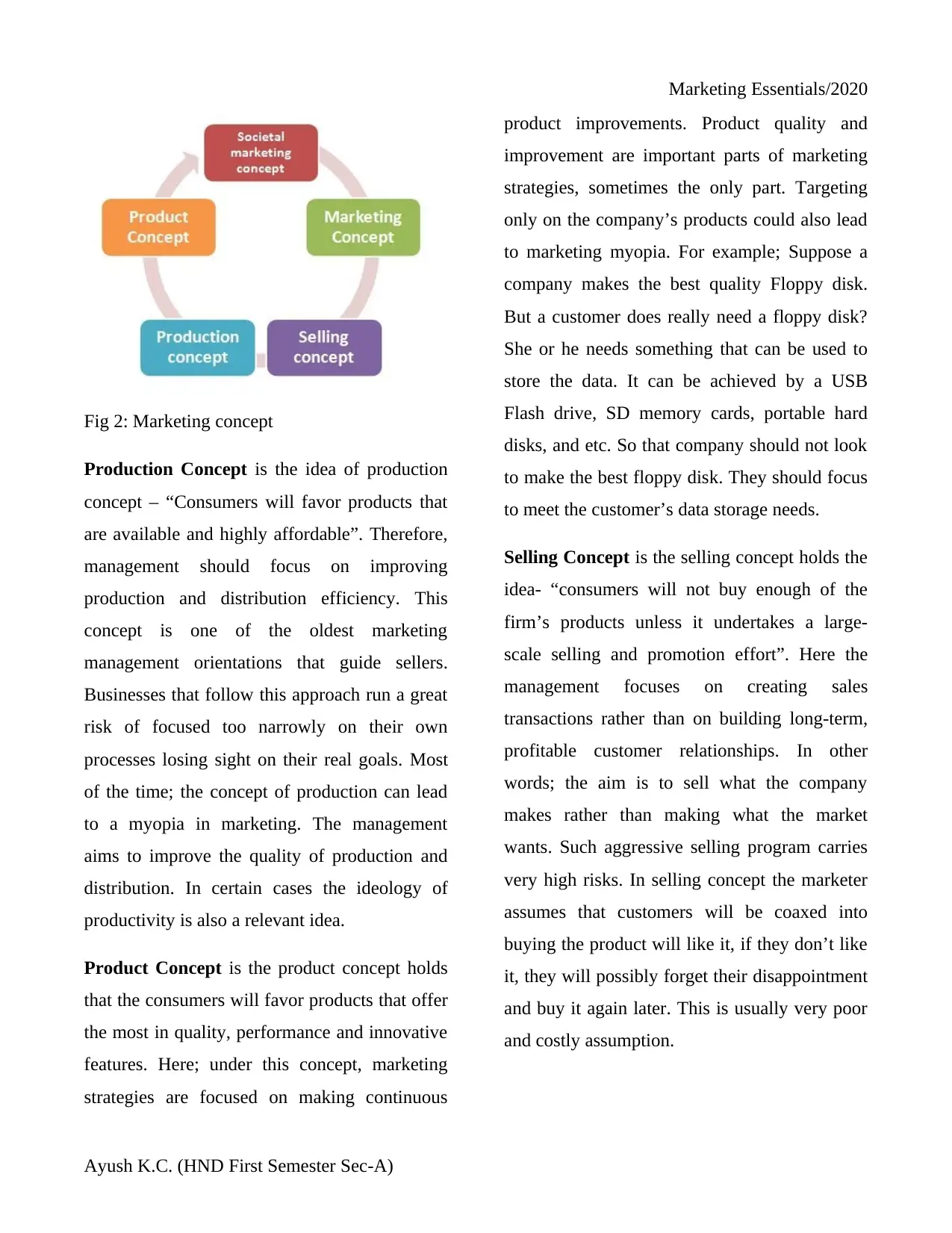
Marketing Essentials/2020
Fig 2: Marketing concept
Production Concept is the idea of production
concept – “Consumers will favor products that
are available and highly affordable”. Therefore,
management should focus on improving
production and distribution efficiency. This
concept is one of the oldest marketing
management orientations that guide sellers.
Businesses that follow this approach run a great
risk of focused too narrowly on their own
processes losing sight on their real goals. Most
of the time; the concept of production can lead
to a myopia in marketing. The management
aims to improve the quality of production and
distribution. In certain cases the ideology of
productivity is also a relevant idea.
Product Concept is the product concept holds
that the consumers will favor products that offer
the most in quality, performance and innovative
features. Here; under this concept, marketing
strategies are focused on making continuous
product improvements. Product quality and
improvement are important parts of marketing
strategies, sometimes the only part. Targeting
only on the company’s products could also lead
to marketing myopia. For example; Suppose a
company makes the best quality Floppy disk.
But a customer does really need a floppy disk?
She or he needs something that can be used to
store the data. It can be achieved by a USB
Flash drive, SD memory cards, portable hard
disks, and etc. So that company should not look
to make the best floppy disk. They should focus
to meet the customer’s data storage needs.
Selling Concept is the selling concept holds the
idea- “consumers will not buy enough of the
firm’s products unless it undertakes a large-
scale selling and promotion effort”. Here the
management focuses on creating sales
transactions rather than on building long-term,
profitable customer relationships. In other
words; the aim is to sell what the company
makes rather than making what the market
wants. Such aggressive selling program carries
very high risks. In selling concept the marketer
assumes that customers will be coaxed into
buying the product will like it, if they don’t like
it, they will possibly forget their disappointment
and buy it again later. This is usually very poor
and costly assumption.
Ayush K.C. (HND First Semester Sec-A)
Fig 2: Marketing concept
Production Concept is the idea of production
concept – “Consumers will favor products that
are available and highly affordable”. Therefore,
management should focus on improving
production and distribution efficiency. This
concept is one of the oldest marketing
management orientations that guide sellers.
Businesses that follow this approach run a great
risk of focused too narrowly on their own
processes losing sight on their real goals. Most
of the time; the concept of production can lead
to a myopia in marketing. The management
aims to improve the quality of production and
distribution. In certain cases the ideology of
productivity is also a relevant idea.
Product Concept is the product concept holds
that the consumers will favor products that offer
the most in quality, performance and innovative
features. Here; under this concept, marketing
strategies are focused on making continuous
product improvements. Product quality and
improvement are important parts of marketing
strategies, sometimes the only part. Targeting
only on the company’s products could also lead
to marketing myopia. For example; Suppose a
company makes the best quality Floppy disk.
But a customer does really need a floppy disk?
She or he needs something that can be used to
store the data. It can be achieved by a USB
Flash drive, SD memory cards, portable hard
disks, and etc. So that company should not look
to make the best floppy disk. They should focus
to meet the customer’s data storage needs.
Selling Concept is the selling concept holds the
idea- “consumers will not buy enough of the
firm’s products unless it undertakes a large-
scale selling and promotion effort”. Here the
management focuses on creating sales
transactions rather than on building long-term,
profitable customer relationships. In other
words; the aim is to sell what the company
makes rather than making what the market
wants. Such aggressive selling program carries
very high risks. In selling concept the marketer
assumes that customers will be coaxed into
buying the product will like it, if they don’t like
it, they will possibly forget their disappointment
and buy it again later. This is usually very poor
and costly assumption.
Ayush K.C. (HND First Semester Sec-A)
⊘ This is a preview!⊘
Do you want full access?
Subscribe today to unlock all pages.

Trusted by 1+ million students worldwide
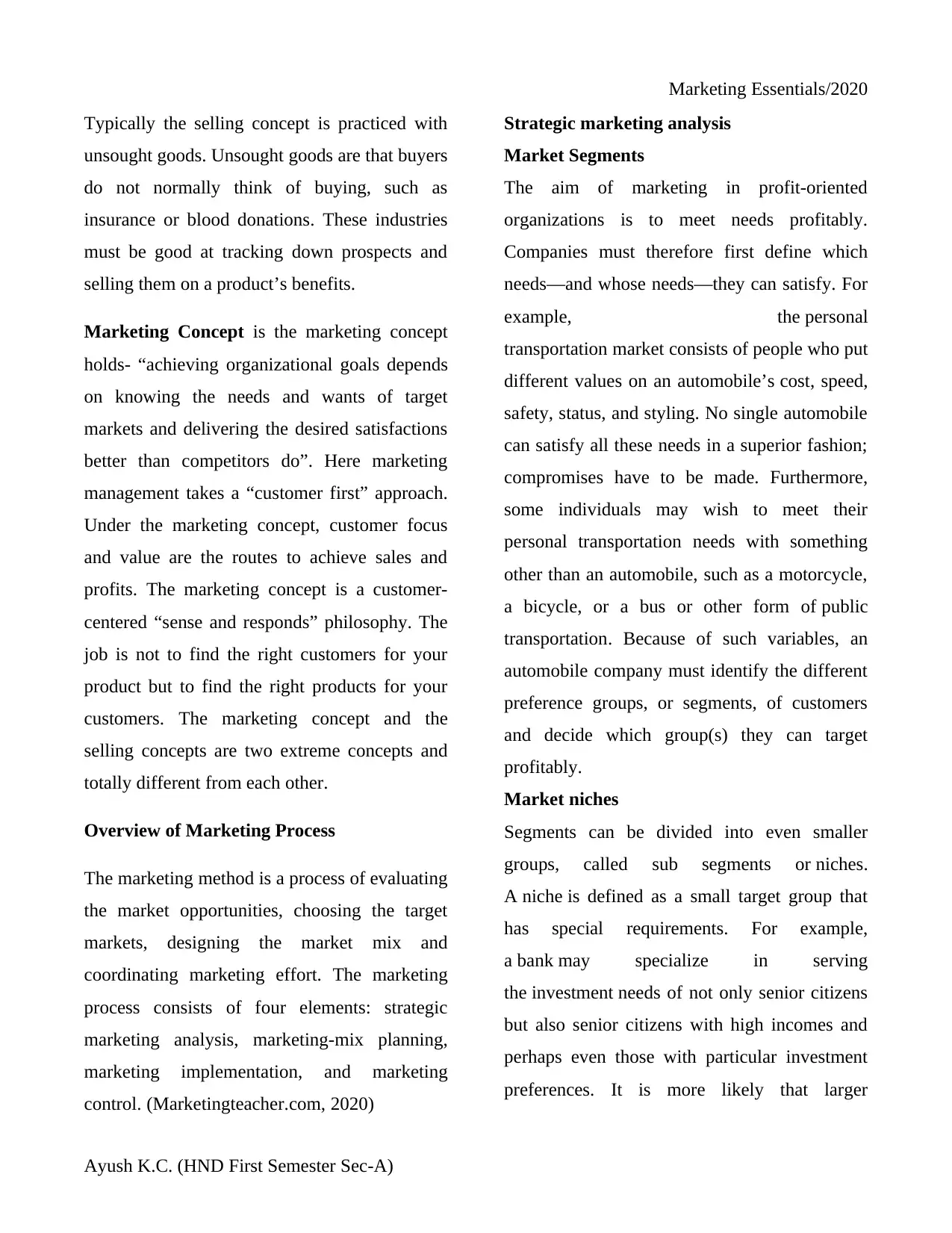
Marketing Essentials/2020
Typically the selling concept is practiced with
unsought goods. Unsought goods are that buyers
do not normally think of buying, such as
insurance or blood donations. These industries
must be good at tracking down prospects and
selling them on a product’s benefits.
Marketing Concept is the marketing concept
holds- “achieving organizational goals depends
on knowing the needs and wants of target
markets and delivering the desired satisfactions
better than competitors do”. Here marketing
management takes a “customer first” approach.
Under the marketing concept, customer focus
and value are the routes to achieve sales and
profits. The marketing concept is a customer-
centered “sense and responds” philosophy. The
job is not to find the right customers for your
product but to find the right products for your
customers. The marketing concept and the
selling concepts are two extreme concepts and
totally different from each other.
Overview of Marketing Process
The marketing method is a process of evaluating
the market opportunities, choosing the target
markets, designing the market mix and
coordinating marketing effort. The marketing
process consists of four elements: strategic
marketing analysis, marketing-mix planning,
marketing implementation, and marketing
control. (Marketingteacher.com, 2020)
Strategic marketing analysis
Market Segments
The aim of marketing in profit-oriented
organizations is to meet needs profitably.
Companies must therefore first define which
needs—and whose needs—they can satisfy. For
example, the personal
transportation market consists of people who put
different values on an automobile’s cost, speed,
safety, status, and styling. No single automobile
can satisfy all these needs in a superior fashion;
compromises have to be made. Furthermore,
some individuals may wish to meet their
personal transportation needs with something
other than an automobile, such as a motorcycle,
a bicycle, or a bus or other form of public
transportation. Because of such variables, an
automobile company must identify the different
preference groups, or segments, of customers
and decide which group(s) they can target
profitably.
Market niches
Segments can be divided into even smaller
groups, called sub segments or niches.
A niche is defined as a small target group that
has special requirements. For example,
a bank may specialize in serving
the investment needs of not only senior citizens
but also senior citizens with high incomes and
perhaps even those with particular investment
preferences. It is more likely that larger
Ayush K.C. (HND First Semester Sec-A)
Typically the selling concept is practiced with
unsought goods. Unsought goods are that buyers
do not normally think of buying, such as
insurance or blood donations. These industries
must be good at tracking down prospects and
selling them on a product’s benefits.
Marketing Concept is the marketing concept
holds- “achieving organizational goals depends
on knowing the needs and wants of target
markets and delivering the desired satisfactions
better than competitors do”. Here marketing
management takes a “customer first” approach.
Under the marketing concept, customer focus
and value are the routes to achieve sales and
profits. The marketing concept is a customer-
centered “sense and responds” philosophy. The
job is not to find the right customers for your
product but to find the right products for your
customers. The marketing concept and the
selling concepts are two extreme concepts and
totally different from each other.
Overview of Marketing Process
The marketing method is a process of evaluating
the market opportunities, choosing the target
markets, designing the market mix and
coordinating marketing effort. The marketing
process consists of four elements: strategic
marketing analysis, marketing-mix planning,
marketing implementation, and marketing
control. (Marketingteacher.com, 2020)
Strategic marketing analysis
Market Segments
The aim of marketing in profit-oriented
organizations is to meet needs profitably.
Companies must therefore first define which
needs—and whose needs—they can satisfy. For
example, the personal
transportation market consists of people who put
different values on an automobile’s cost, speed,
safety, status, and styling. No single automobile
can satisfy all these needs in a superior fashion;
compromises have to be made. Furthermore,
some individuals may wish to meet their
personal transportation needs with something
other than an automobile, such as a motorcycle,
a bicycle, or a bus or other form of public
transportation. Because of such variables, an
automobile company must identify the different
preference groups, or segments, of customers
and decide which group(s) they can target
profitably.
Market niches
Segments can be divided into even smaller
groups, called sub segments or niches.
A niche is defined as a small target group that
has special requirements. For example,
a bank may specialize in serving
the investment needs of not only senior citizens
but also senior citizens with high incomes and
perhaps even those with particular investment
preferences. It is more likely that larger
Ayush K.C. (HND First Semester Sec-A)
Paraphrase This Document
Need a fresh take? Get an instant paraphrase of this document with our AI Paraphraser
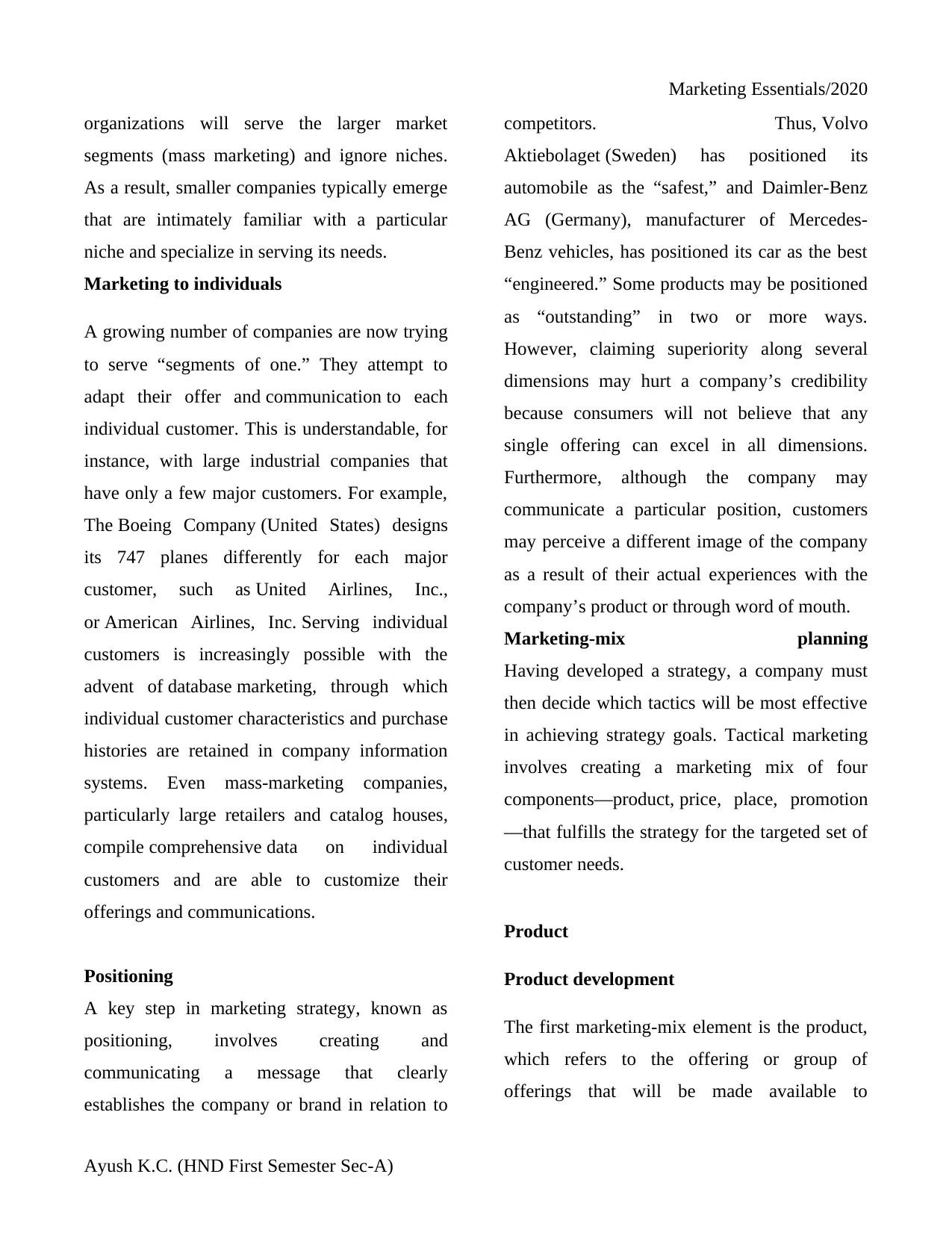
Marketing Essentials/2020
organizations will serve the larger market
segments (mass marketing) and ignore niches.
As a result, smaller companies typically emerge
that are intimately familiar with a particular
niche and specialize in serving its needs.
Marketing to individuals
A growing number of companies are now trying
to serve “segments of one.” They attempt to
adapt their offer and communication to each
individual customer. This is understandable, for
instance, with large industrial companies that
have only a few major customers. For example,
The Boeing Company (United States) designs
its 747 planes differently for each major
customer, such as United Airlines, Inc.,
or American Airlines, Inc. Serving individual
customers is increasingly possible with the
advent of database marketing, through which
individual customer characteristics and purchase
histories are retained in company information
systems. Even mass-marketing companies,
particularly large retailers and catalog houses,
compile comprehensive data on individual
customers and are able to customize their
offerings and communications.
Positioning
A key step in marketing strategy, known as
positioning, involves creating and
communicating a message that clearly
establishes the company or brand in relation to
competitors. Thus, Volvo
Aktiebolaget (Sweden) has positioned its
automobile as the “safest,” and Daimler-Benz
AG (Germany), manufacturer of Mercedes-
Benz vehicles, has positioned its car as the best
“engineered.” Some products may be positioned
as “outstanding” in two or more ways.
However, claiming superiority along several
dimensions may hurt a company’s credibility
because consumers will not believe that any
single offering can excel in all dimensions.
Furthermore, although the company may
communicate a particular position, customers
may perceive a different image of the company
as a result of their actual experiences with the
company’s product or through word of mouth.
Marketing-mix planning
Having developed a strategy, a company must
then decide which tactics will be most effective
in achieving strategy goals. Tactical marketing
involves creating a marketing mix of four
components—product, price, place, promotion
—that fulfills the strategy for the targeted set of
customer needs.
Product
Product development
The first marketing-mix element is the product,
which refers to the offering or group of
offerings that will be made available to
Ayush K.C. (HND First Semester Sec-A)
organizations will serve the larger market
segments (mass marketing) and ignore niches.
As a result, smaller companies typically emerge
that are intimately familiar with a particular
niche and specialize in serving its needs.
Marketing to individuals
A growing number of companies are now trying
to serve “segments of one.” They attempt to
adapt their offer and communication to each
individual customer. This is understandable, for
instance, with large industrial companies that
have only a few major customers. For example,
The Boeing Company (United States) designs
its 747 planes differently for each major
customer, such as United Airlines, Inc.,
or American Airlines, Inc. Serving individual
customers is increasingly possible with the
advent of database marketing, through which
individual customer characteristics and purchase
histories are retained in company information
systems. Even mass-marketing companies,
particularly large retailers and catalog houses,
compile comprehensive data on individual
customers and are able to customize their
offerings and communications.
Positioning
A key step in marketing strategy, known as
positioning, involves creating and
communicating a message that clearly
establishes the company or brand in relation to
competitors. Thus, Volvo
Aktiebolaget (Sweden) has positioned its
automobile as the “safest,” and Daimler-Benz
AG (Germany), manufacturer of Mercedes-
Benz vehicles, has positioned its car as the best
“engineered.” Some products may be positioned
as “outstanding” in two or more ways.
However, claiming superiority along several
dimensions may hurt a company’s credibility
because consumers will not believe that any
single offering can excel in all dimensions.
Furthermore, although the company may
communicate a particular position, customers
may perceive a different image of the company
as a result of their actual experiences with the
company’s product or through word of mouth.
Marketing-mix planning
Having developed a strategy, a company must
then decide which tactics will be most effective
in achieving strategy goals. Tactical marketing
involves creating a marketing mix of four
components—product, price, place, promotion
—that fulfills the strategy for the targeted set of
customer needs.
Product
Product development
The first marketing-mix element is the product,
which refers to the offering or group of
offerings that will be made available to
Ayush K.C. (HND First Semester Sec-A)
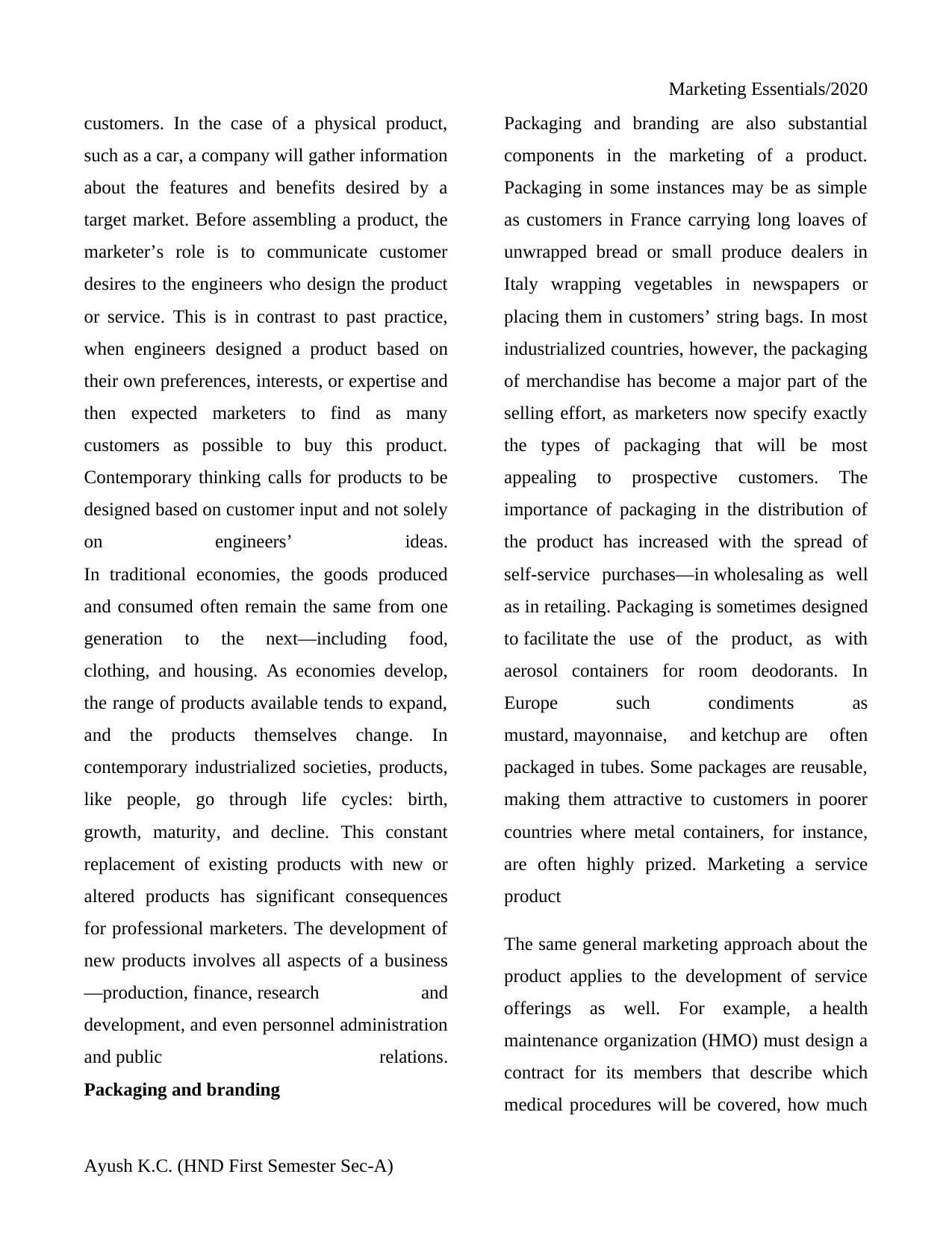
Marketing Essentials/2020
customers. In the case of a physical product,
such as a car, a company will gather information
about the features and benefits desired by a
target market. Before assembling a product, the
marketer’s role is to communicate customer
desires to the engineers who design the product
or service. This is in contrast to past practice,
when engineers designed a product based on
their own preferences, interests, or expertise and
then expected marketers to find as many
customers as possible to buy this product.
Contemporary thinking calls for products to be
designed based on customer input and not solely
on engineers’ ideas.
In traditional economies, the goods produced
and consumed often remain the same from one
generation to the next—including food,
clothing, and housing. As economies develop,
the range of products available tends to expand,
and the products themselves change. In
contemporary industrialized societies, products,
like people, go through life cycles: birth,
growth, maturity, and decline. This constant
replacement of existing products with new or
altered products has significant consequences
for professional marketers. The development of
new products involves all aspects of a business
—production, finance, research and
development, and even personnel administration
and public relations.
Packaging and branding
Packaging and branding are also substantial
components in the marketing of a product.
Packaging in some instances may be as simple
as customers in France carrying long loaves of
unwrapped bread or small produce dealers in
Italy wrapping vegetables in newspapers or
placing them in customers’ string bags. In most
industrialized countries, however, the packaging
of merchandise has become a major part of the
selling effort, as marketers now specify exactly
the types of packaging that will be most
appealing to prospective customers. The
importance of packaging in the distribution of
the product has increased with the spread of
self-service purchases—in wholesaling as well
as in retailing. Packaging is sometimes designed
to facilitate the use of the product, as with
aerosol containers for room deodorants. In
Europe such condiments as
mustard, mayonnaise, and ketchup are often
packaged in tubes. Some packages are reusable,
making them attractive to customers in poorer
countries where metal containers, for instance,
are often highly prized. Marketing a service
product
The same general marketing approach about the
product applies to the development of service
offerings as well. For example, a health
maintenance organization (HMO) must design a
contract for its members that describe which
medical procedures will be covered, how much
Ayush K.C. (HND First Semester Sec-A)
customers. In the case of a physical product,
such as a car, a company will gather information
about the features and benefits desired by a
target market. Before assembling a product, the
marketer’s role is to communicate customer
desires to the engineers who design the product
or service. This is in contrast to past practice,
when engineers designed a product based on
their own preferences, interests, or expertise and
then expected marketers to find as many
customers as possible to buy this product.
Contemporary thinking calls for products to be
designed based on customer input and not solely
on engineers’ ideas.
In traditional economies, the goods produced
and consumed often remain the same from one
generation to the next—including food,
clothing, and housing. As economies develop,
the range of products available tends to expand,
and the products themselves change. In
contemporary industrialized societies, products,
like people, go through life cycles: birth,
growth, maturity, and decline. This constant
replacement of existing products with new or
altered products has significant consequences
for professional marketers. The development of
new products involves all aspects of a business
—production, finance, research and
development, and even personnel administration
and public relations.
Packaging and branding
Packaging and branding are also substantial
components in the marketing of a product.
Packaging in some instances may be as simple
as customers in France carrying long loaves of
unwrapped bread or small produce dealers in
Italy wrapping vegetables in newspapers or
placing them in customers’ string bags. In most
industrialized countries, however, the packaging
of merchandise has become a major part of the
selling effort, as marketers now specify exactly
the types of packaging that will be most
appealing to prospective customers. The
importance of packaging in the distribution of
the product has increased with the spread of
self-service purchases—in wholesaling as well
as in retailing. Packaging is sometimes designed
to facilitate the use of the product, as with
aerosol containers for room deodorants. In
Europe such condiments as
mustard, mayonnaise, and ketchup are often
packaged in tubes. Some packages are reusable,
making them attractive to customers in poorer
countries where metal containers, for instance,
are often highly prized. Marketing a service
product
The same general marketing approach about the
product applies to the development of service
offerings as well. For example, a health
maintenance organization (HMO) must design a
contract for its members that describe which
medical procedures will be covered, how much
Ayush K.C. (HND First Semester Sec-A)
⊘ This is a preview!⊘
Do you want full access?
Subscribe today to unlock all pages.

Trusted by 1+ million students worldwide
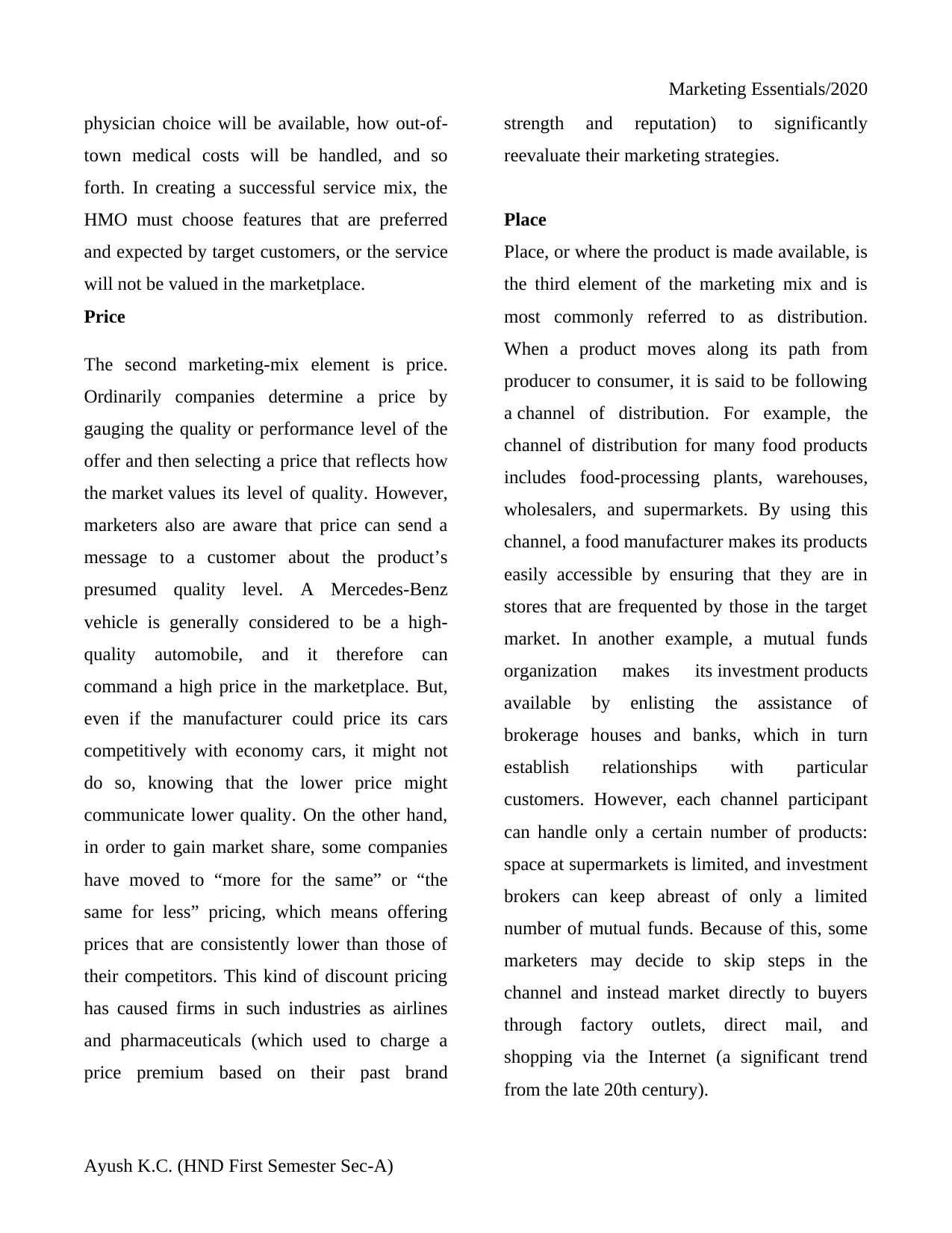
Marketing Essentials/2020
physician choice will be available, how out-of-
town medical costs will be handled, and so
forth. In creating a successful service mix, the
HMO must choose features that are preferred
and expected by target customers, or the service
will not be valued in the marketplace.
Price
The second marketing-mix element is price.
Ordinarily companies determine a price by
gauging the quality or performance level of the
offer and then selecting a price that reflects how
the market values its level of quality. However,
marketers also are aware that price can send a
message to a customer about the product’s
presumed quality level. A Mercedes-Benz
vehicle is generally considered to be a high-
quality automobile, and it therefore can
command a high price in the marketplace. But,
even if the manufacturer could price its cars
competitively with economy cars, it might not
do so, knowing that the lower price might
communicate lower quality. On the other hand,
in order to gain market share, some companies
have moved to “more for the same” or “the
same for less” pricing, which means offering
prices that are consistently lower than those of
their competitors. This kind of discount pricing
has caused firms in such industries as airlines
and pharmaceuticals (which used to charge a
price premium based on their past brand
strength and reputation) to significantly
reevaluate their marketing strategies.
Place
Place, or where the product is made available, is
the third element of the marketing mix and is
most commonly referred to as distribution.
When a product moves along its path from
producer to consumer, it is said to be following
a channel of distribution. For example, the
channel of distribution for many food products
includes food-processing plants, warehouses,
wholesalers, and supermarkets. By using this
channel, a food manufacturer makes its products
easily accessible by ensuring that they are in
stores that are frequented by those in the target
market. In another example, a mutual funds
organization makes its investment products
available by enlisting the assistance of
brokerage houses and banks, which in turn
establish relationships with particular
customers. However, each channel participant
can handle only a certain number of products:
space at supermarkets is limited, and investment
brokers can keep abreast of only a limited
number of mutual funds. Because of this, some
marketers may decide to skip steps in the
channel and instead market directly to buyers
through factory outlets, direct mail, and
shopping via the Internet (a significant trend
from the late 20th century).
Ayush K.C. (HND First Semester Sec-A)
physician choice will be available, how out-of-
town medical costs will be handled, and so
forth. In creating a successful service mix, the
HMO must choose features that are preferred
and expected by target customers, or the service
will not be valued in the marketplace.
Price
The second marketing-mix element is price.
Ordinarily companies determine a price by
gauging the quality or performance level of the
offer and then selecting a price that reflects how
the market values its level of quality. However,
marketers also are aware that price can send a
message to a customer about the product’s
presumed quality level. A Mercedes-Benz
vehicle is generally considered to be a high-
quality automobile, and it therefore can
command a high price in the marketplace. But,
even if the manufacturer could price its cars
competitively with economy cars, it might not
do so, knowing that the lower price might
communicate lower quality. On the other hand,
in order to gain market share, some companies
have moved to “more for the same” or “the
same for less” pricing, which means offering
prices that are consistently lower than those of
their competitors. This kind of discount pricing
has caused firms in such industries as airlines
and pharmaceuticals (which used to charge a
price premium based on their past brand
strength and reputation) to significantly
reevaluate their marketing strategies.
Place
Place, or where the product is made available, is
the third element of the marketing mix and is
most commonly referred to as distribution.
When a product moves along its path from
producer to consumer, it is said to be following
a channel of distribution. For example, the
channel of distribution for many food products
includes food-processing plants, warehouses,
wholesalers, and supermarkets. By using this
channel, a food manufacturer makes its products
easily accessible by ensuring that they are in
stores that are frequented by those in the target
market. In another example, a mutual funds
organization makes its investment products
available by enlisting the assistance of
brokerage houses and banks, which in turn
establish relationships with particular
customers. However, each channel participant
can handle only a certain number of products:
space at supermarkets is limited, and investment
brokers can keep abreast of only a limited
number of mutual funds. Because of this, some
marketers may decide to skip steps in the
channel and instead market directly to buyers
through factory outlets, direct mail, and
shopping via the Internet (a significant trend
from the late 20th century).
Ayush K.C. (HND First Semester Sec-A)
Paraphrase This Document
Need a fresh take? Get an instant paraphrase of this document with our AI Paraphraser
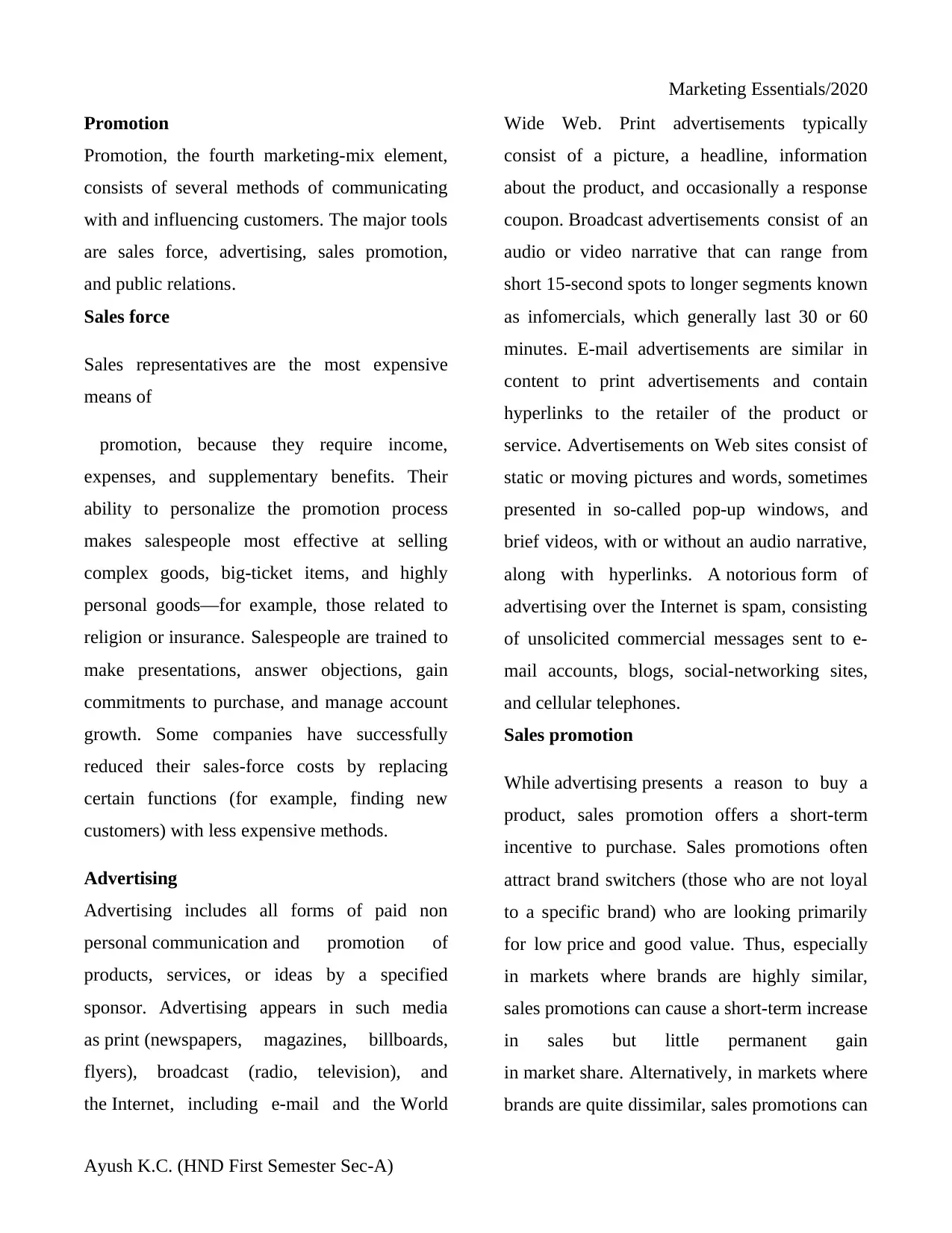
Marketing Essentials/2020
Promotion
Promotion, the fourth marketing-mix element,
consists of several methods of communicating
with and influencing customers. The major tools
are sales force, advertising, sales promotion,
and public relations.
Sales force
Sales representatives are the most expensive
means of
promotion, because they require income,
expenses, and supplementary benefits. Their
ability to personalize the promotion process
makes salespeople most effective at selling
complex goods, big-ticket items, and highly
personal goods—for example, those related to
religion or insurance. Salespeople are trained to
make presentations, answer objections, gain
commitments to purchase, and manage account
growth. Some companies have successfully
reduced their sales-force costs by replacing
certain functions (for example, finding new
customers) with less expensive methods.
Advertising
Advertising includes all forms of paid non
personal communication and promotion of
products, services, or ideas by a specified
sponsor. Advertising appears in such media
as print (newspapers, magazines, billboards,
flyers), broadcast (radio, television), and
the Internet, including e-mail and the World
Wide Web. Print advertisements typically
consist of a picture, a headline, information
about the product, and occasionally a response
coupon. Broadcast advertisements consist of an
audio or video narrative that can range from
short 15-second spots to longer segments known
as infomercials, which generally last 30 or 60
minutes. E-mail advertisements are similar in
content to print advertisements and contain
hyperlinks to the retailer of the product or
service. Advertisements on Web sites consist of
static or moving pictures and words, sometimes
presented in so-called pop-up windows, and
brief videos, with or without an audio narrative,
along with hyperlinks. A notorious form of
advertising over the Internet is spam, consisting
of unsolicited commercial messages sent to e-
mail accounts, blogs, social-networking sites,
and cellular telephones.
Sales promotion
While advertising presents a reason to buy a
product, sales promotion offers a short-term
incentive to purchase. Sales promotions often
attract brand switchers (those who are not loyal
to a specific brand) who are looking primarily
for low price and good value. Thus, especially
in markets where brands are highly similar,
sales promotions can cause a short-term increase
in sales but little permanent gain
in market share. Alternatively, in markets where
brands are quite dissimilar, sales promotions can
Ayush K.C. (HND First Semester Sec-A)
Promotion
Promotion, the fourth marketing-mix element,
consists of several methods of communicating
with and influencing customers. The major tools
are sales force, advertising, sales promotion,
and public relations.
Sales force
Sales representatives are the most expensive
means of
promotion, because they require income,
expenses, and supplementary benefits. Their
ability to personalize the promotion process
makes salespeople most effective at selling
complex goods, big-ticket items, and highly
personal goods—for example, those related to
religion or insurance. Salespeople are trained to
make presentations, answer objections, gain
commitments to purchase, and manage account
growth. Some companies have successfully
reduced their sales-force costs by replacing
certain functions (for example, finding new
customers) with less expensive methods.
Advertising
Advertising includes all forms of paid non
personal communication and promotion of
products, services, or ideas by a specified
sponsor. Advertising appears in such media
as print (newspapers, magazines, billboards,
flyers), broadcast (radio, television), and
the Internet, including e-mail and the World
Wide Web. Print advertisements typically
consist of a picture, a headline, information
about the product, and occasionally a response
coupon. Broadcast advertisements consist of an
audio or video narrative that can range from
short 15-second spots to longer segments known
as infomercials, which generally last 30 or 60
minutes. E-mail advertisements are similar in
content to print advertisements and contain
hyperlinks to the retailer of the product or
service. Advertisements on Web sites consist of
static or moving pictures and words, sometimes
presented in so-called pop-up windows, and
brief videos, with or without an audio narrative,
along with hyperlinks. A notorious form of
advertising over the Internet is spam, consisting
of unsolicited commercial messages sent to e-
mail accounts, blogs, social-networking sites,
and cellular telephones.
Sales promotion
While advertising presents a reason to buy a
product, sales promotion offers a short-term
incentive to purchase. Sales promotions often
attract brand switchers (those who are not loyal
to a specific brand) who are looking primarily
for low price and good value. Thus, especially
in markets where brands are highly similar,
sales promotions can cause a short-term increase
in sales but little permanent gain
in market share. Alternatively, in markets where
brands are quite dissimilar, sales promotions can
Ayush K.C. (HND First Semester Sec-A)
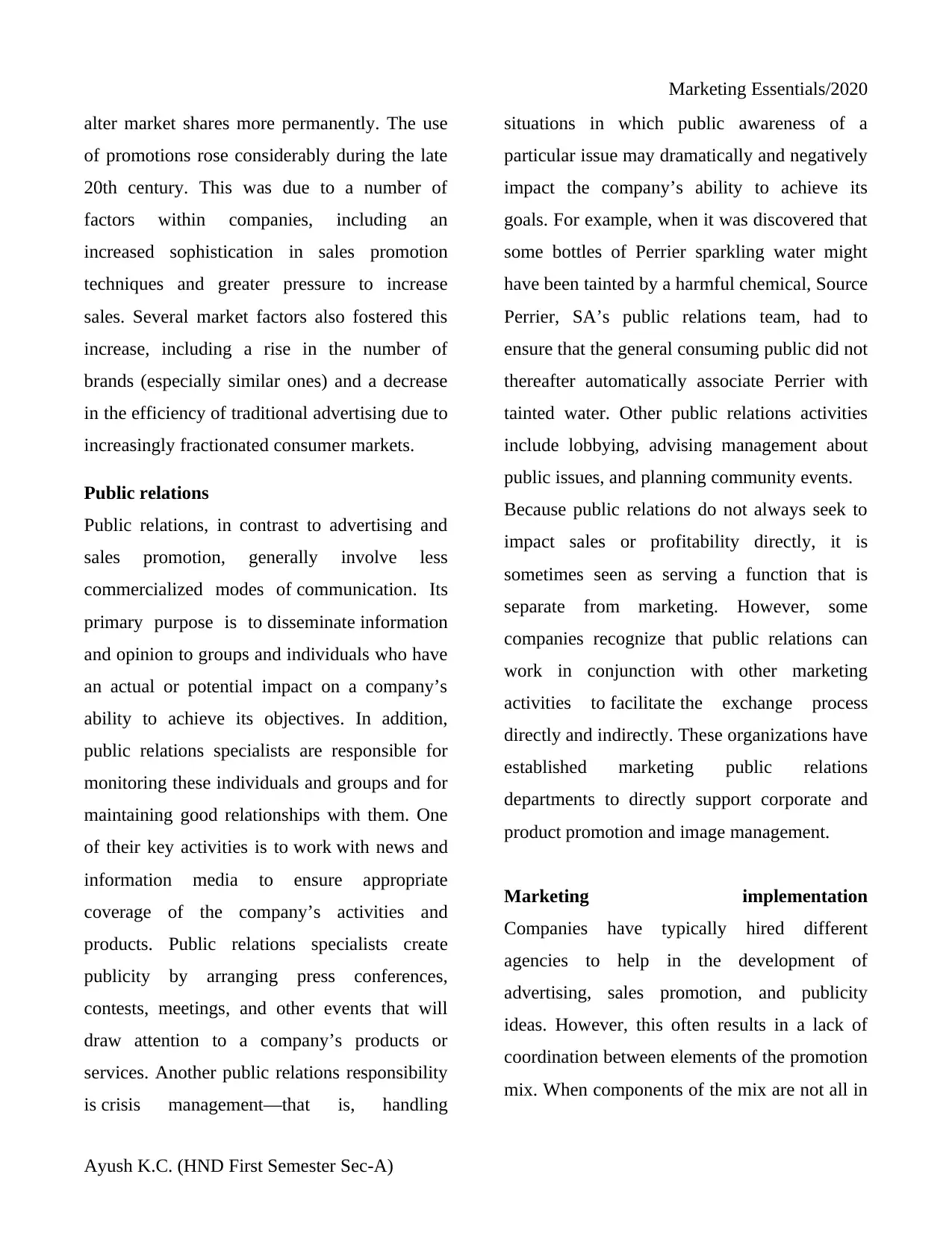
Marketing Essentials/2020
alter market shares more permanently. The use
of promotions rose considerably during the late
20th century. This was due to a number of
factors within companies, including an
increased sophistication in sales promotion
techniques and greater pressure to increase
sales. Several market factors also fostered this
increase, including a rise in the number of
brands (especially similar ones) and a decrease
in the efficiency of traditional advertising due to
increasingly fractionated consumer markets.
Public relations
Public relations, in contrast to advertising and
sales promotion, generally involve less
commercialized modes of communication. Its
primary purpose is to disseminate information
and opinion to groups and individuals who have
an actual or potential impact on a company’s
ability to achieve its objectives. In addition,
public relations specialists are responsible for
monitoring these individuals and groups and for
maintaining good relationships with them. One
of their key activities is to work with news and
information media to ensure appropriate
coverage of the company’s activities and
products. Public relations specialists create
publicity by arranging press conferences,
contests, meetings, and other events that will
draw attention to a company’s products or
services. Another public relations responsibility
is crisis management—that is, handling
situations in which public awareness of a
particular issue may dramatically and negatively
impact the company’s ability to achieve its
goals. For example, when it was discovered that
some bottles of Perrier sparkling water might
have been tainted by a harmful chemical, Source
Perrier, SA’s public relations team, had to
ensure that the general consuming public did not
thereafter automatically associate Perrier with
tainted water. Other public relations activities
include lobbying, advising management about
public issues, and planning community events.
Because public relations do not always seek to
impact sales or profitability directly, it is
sometimes seen as serving a function that is
separate from marketing. However, some
companies recognize that public relations can
work in conjunction with other marketing
activities to facilitate the exchange process
directly and indirectly. These organizations have
established marketing public relations
departments to directly support corporate and
product promotion and image management.
Marketing implementation
Companies have typically hired different
agencies to help in the development of
advertising, sales promotion, and publicity
ideas. However, this often results in a lack of
coordination between elements of the promotion
mix. When components of the mix are not all in
Ayush K.C. (HND First Semester Sec-A)
alter market shares more permanently. The use
of promotions rose considerably during the late
20th century. This was due to a number of
factors within companies, including an
increased sophistication in sales promotion
techniques and greater pressure to increase
sales. Several market factors also fostered this
increase, including a rise in the number of
brands (especially similar ones) and a decrease
in the efficiency of traditional advertising due to
increasingly fractionated consumer markets.
Public relations
Public relations, in contrast to advertising and
sales promotion, generally involve less
commercialized modes of communication. Its
primary purpose is to disseminate information
and opinion to groups and individuals who have
an actual or potential impact on a company’s
ability to achieve its objectives. In addition,
public relations specialists are responsible for
monitoring these individuals and groups and for
maintaining good relationships with them. One
of their key activities is to work with news and
information media to ensure appropriate
coverage of the company’s activities and
products. Public relations specialists create
publicity by arranging press conferences,
contests, meetings, and other events that will
draw attention to a company’s products or
services. Another public relations responsibility
is crisis management—that is, handling
situations in which public awareness of a
particular issue may dramatically and negatively
impact the company’s ability to achieve its
goals. For example, when it was discovered that
some bottles of Perrier sparkling water might
have been tainted by a harmful chemical, Source
Perrier, SA’s public relations team, had to
ensure that the general consuming public did not
thereafter automatically associate Perrier with
tainted water. Other public relations activities
include lobbying, advising management about
public issues, and planning community events.
Because public relations do not always seek to
impact sales or profitability directly, it is
sometimes seen as serving a function that is
separate from marketing. However, some
companies recognize that public relations can
work in conjunction with other marketing
activities to facilitate the exchange process
directly and indirectly. These organizations have
established marketing public relations
departments to directly support corporate and
product promotion and image management.
Marketing implementation
Companies have typically hired different
agencies to help in the development of
advertising, sales promotion, and publicity
ideas. However, this often results in a lack of
coordination between elements of the promotion
mix. When components of the mix are not all in
Ayush K.C. (HND First Semester Sec-A)
⊘ This is a preview!⊘
Do you want full access?
Subscribe today to unlock all pages.

Trusted by 1+ million students worldwide
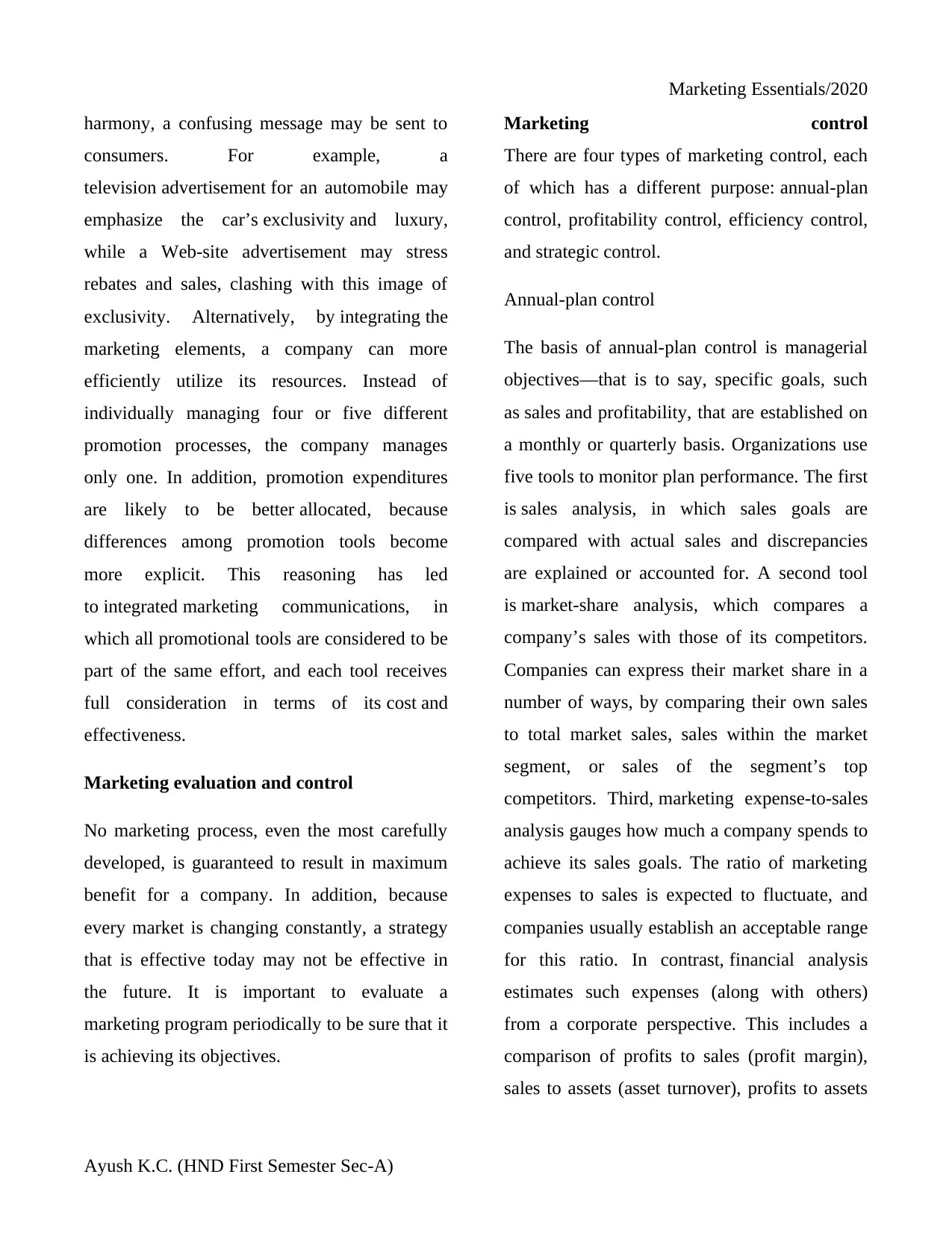
Marketing Essentials/2020
harmony, a confusing message may be sent to
consumers. For example, a
television advertisement for an automobile may
emphasize the car’s exclusivity and luxury,
while a Web-site advertisement may stress
rebates and sales, clashing with this image of
exclusivity. Alternatively, by integrating the
marketing elements, a company can more
efficiently utilize its resources. Instead of
individually managing four or five different
promotion processes, the company manages
only one. In addition, promotion expenditures
are likely to be better allocated, because
differences among promotion tools become
more explicit. This reasoning has led
to integrated marketing communications, in
which all promotional tools are considered to be
part of the same effort, and each tool receives
full consideration in terms of its cost and
effectiveness.
Marketing evaluation and control
No marketing process, even the most carefully
developed, is guaranteed to result in maximum
benefit for a company. In addition, because
every market is changing constantly, a strategy
that is effective today may not be effective in
the future. It is important to evaluate a
marketing program periodically to be sure that it
is achieving its objectives.
Marketing control
There are four types of marketing control, each
of which has a different purpose: annual-plan
control, profitability control, efficiency control,
and strategic control.
Annual-plan control
The basis of annual-plan control is managerial
objectives—that is to say, specific goals, such
as sales and profitability, that are established on
a monthly or quarterly basis. Organizations use
five tools to monitor plan performance. The first
is sales analysis, in which sales goals are
compared with actual sales and discrepancies
are explained or accounted for. A second tool
is market-share analysis, which compares a
company’s sales with those of its competitors.
Companies can express their market share in a
number of ways, by comparing their own sales
to total market sales, sales within the market
segment, or sales of the segment’s top
competitors. Third, marketing expense-to-sales
analysis gauges how much a company spends to
achieve its sales goals. The ratio of marketing
expenses to sales is expected to fluctuate, and
companies usually establish an acceptable range
for this ratio. In contrast, financial analysis
estimates such expenses (along with others)
from a corporate perspective. This includes a
comparison of profits to sales (profit margin),
sales to assets (asset turnover), profits to assets
Ayush K.C. (HND First Semester Sec-A)
harmony, a confusing message may be sent to
consumers. For example, a
television advertisement for an automobile may
emphasize the car’s exclusivity and luxury,
while a Web-site advertisement may stress
rebates and sales, clashing with this image of
exclusivity. Alternatively, by integrating the
marketing elements, a company can more
efficiently utilize its resources. Instead of
individually managing four or five different
promotion processes, the company manages
only one. In addition, promotion expenditures
are likely to be better allocated, because
differences among promotion tools become
more explicit. This reasoning has led
to integrated marketing communications, in
which all promotional tools are considered to be
part of the same effort, and each tool receives
full consideration in terms of its cost and
effectiveness.
Marketing evaluation and control
No marketing process, even the most carefully
developed, is guaranteed to result in maximum
benefit for a company. In addition, because
every market is changing constantly, a strategy
that is effective today may not be effective in
the future. It is important to evaluate a
marketing program periodically to be sure that it
is achieving its objectives.
Marketing control
There are four types of marketing control, each
of which has a different purpose: annual-plan
control, profitability control, efficiency control,
and strategic control.
Annual-plan control
The basis of annual-plan control is managerial
objectives—that is to say, specific goals, such
as sales and profitability, that are established on
a monthly or quarterly basis. Organizations use
five tools to monitor plan performance. The first
is sales analysis, in which sales goals are
compared with actual sales and discrepancies
are explained or accounted for. A second tool
is market-share analysis, which compares a
company’s sales with those of its competitors.
Companies can express their market share in a
number of ways, by comparing their own sales
to total market sales, sales within the market
segment, or sales of the segment’s top
competitors. Third, marketing expense-to-sales
analysis gauges how much a company spends to
achieve its sales goals. The ratio of marketing
expenses to sales is expected to fluctuate, and
companies usually establish an acceptable range
for this ratio. In contrast, financial analysis
estimates such expenses (along with others)
from a corporate perspective. This includes a
comparison of profits to sales (profit margin),
sales to assets (asset turnover), profits to assets
Ayush K.C. (HND First Semester Sec-A)
Paraphrase This Document
Need a fresh take? Get an instant paraphrase of this document with our AI Paraphraser
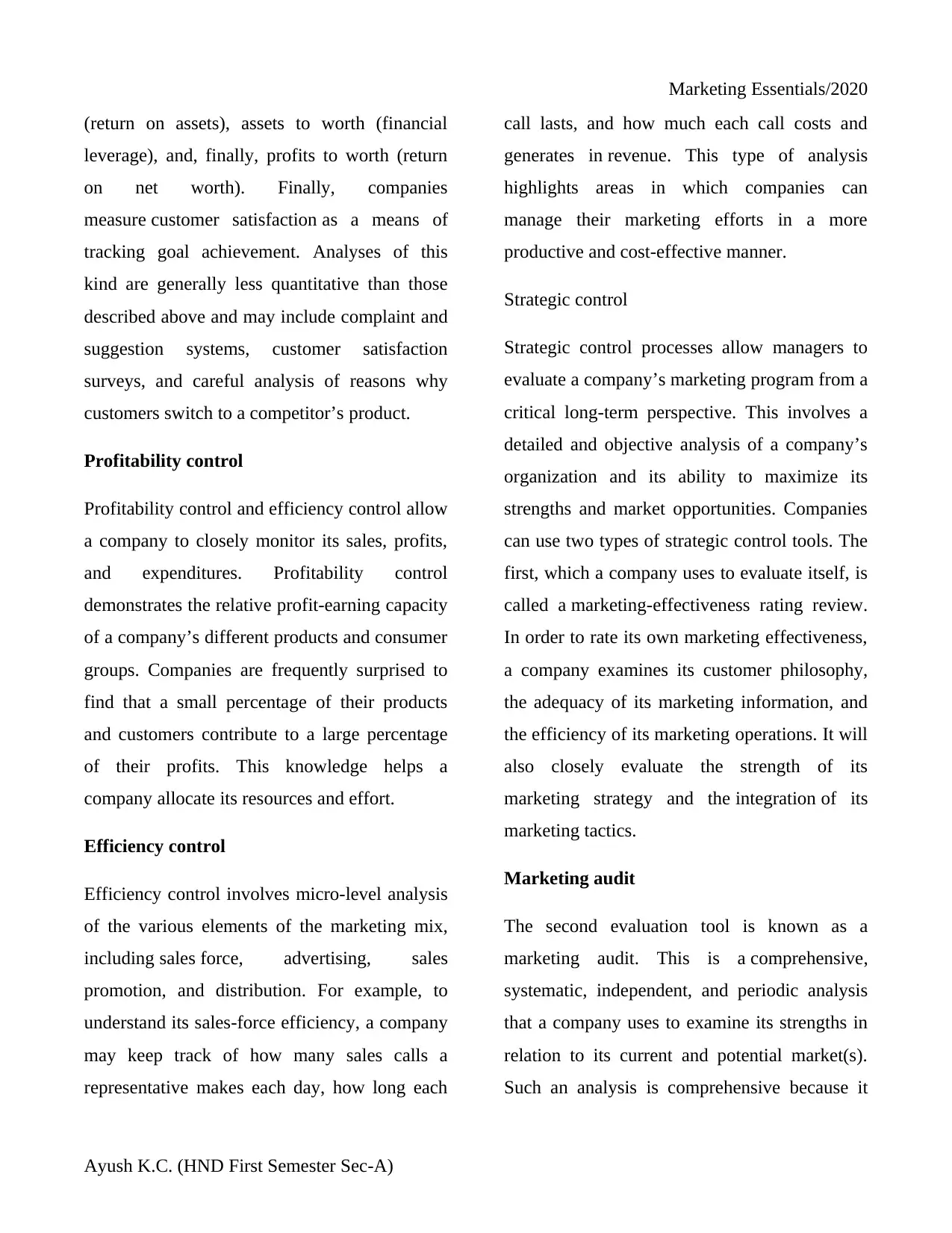
Marketing Essentials/2020
(return on assets), assets to worth (financial
leverage), and, finally, profits to worth (return
on net worth). Finally, companies
measure customer satisfaction as a means of
tracking goal achievement. Analyses of this
kind are generally less quantitative than those
described above and may include complaint and
suggestion systems, customer satisfaction
surveys, and careful analysis of reasons why
customers switch to a competitor’s product.
Profitability control
Profitability control and efficiency control allow
a company to closely monitor its sales, profits,
and expenditures. Profitability control
demonstrates the relative profit-earning capacity
of a company’s different products and consumer
groups. Companies are frequently surprised to
find that a small percentage of their products
and customers contribute to a large percentage
of their profits. This knowledge helps a
company allocate its resources and effort.
Efficiency control
Efficiency control involves micro-level analysis
of the various elements of the marketing mix,
including sales force, advertising, sales
promotion, and distribution. For example, to
understand its sales-force efficiency, a company
may keep track of how many sales calls a
representative makes each day, how long each
call lasts, and how much each call costs and
generates in revenue. This type of analysis
highlights areas in which companies can
manage their marketing efforts in a more
productive and cost-effective manner.
Strategic control
Strategic control processes allow managers to
evaluate a company’s marketing program from a
critical long-term perspective. This involves a
detailed and objective analysis of a company’s
organization and its ability to maximize its
strengths and market opportunities. Companies
can use two types of strategic control tools. The
first, which a company uses to evaluate itself, is
called a marketing-effectiveness rating review.
In order to rate its own marketing effectiveness,
a company examines its customer philosophy,
the adequacy of its marketing information, and
the efficiency of its marketing operations. It will
also closely evaluate the strength of its
marketing strategy and the integration of its
marketing tactics.
Marketing audit
The second evaluation tool is known as a
marketing audit. This is a comprehensive,
systematic, independent, and periodic analysis
that a company uses to examine its strengths in
relation to its current and potential market(s).
Such an analysis is comprehensive because it
Ayush K.C. (HND First Semester Sec-A)
(return on assets), assets to worth (financial
leverage), and, finally, profits to worth (return
on net worth). Finally, companies
measure customer satisfaction as a means of
tracking goal achievement. Analyses of this
kind are generally less quantitative than those
described above and may include complaint and
suggestion systems, customer satisfaction
surveys, and careful analysis of reasons why
customers switch to a competitor’s product.
Profitability control
Profitability control and efficiency control allow
a company to closely monitor its sales, profits,
and expenditures. Profitability control
demonstrates the relative profit-earning capacity
of a company’s different products and consumer
groups. Companies are frequently surprised to
find that a small percentage of their products
and customers contribute to a large percentage
of their profits. This knowledge helps a
company allocate its resources and effort.
Efficiency control
Efficiency control involves micro-level analysis
of the various elements of the marketing mix,
including sales force, advertising, sales
promotion, and distribution. For example, to
understand its sales-force efficiency, a company
may keep track of how many sales calls a
representative makes each day, how long each
call lasts, and how much each call costs and
generates in revenue. This type of analysis
highlights areas in which companies can
manage their marketing efforts in a more
productive and cost-effective manner.
Strategic control
Strategic control processes allow managers to
evaluate a company’s marketing program from a
critical long-term perspective. This involves a
detailed and objective analysis of a company’s
organization and its ability to maximize its
strengths and market opportunities. Companies
can use two types of strategic control tools. The
first, which a company uses to evaluate itself, is
called a marketing-effectiveness rating review.
In order to rate its own marketing effectiveness,
a company examines its customer philosophy,
the adequacy of its marketing information, and
the efficiency of its marketing operations. It will
also closely evaluate the strength of its
marketing strategy and the integration of its
marketing tactics.
Marketing audit
The second evaluation tool is known as a
marketing audit. This is a comprehensive,
systematic, independent, and periodic analysis
that a company uses to examine its strengths in
relation to its current and potential market(s).
Such an analysis is comprehensive because it
Ayush K.C. (HND First Semester Sec-A)
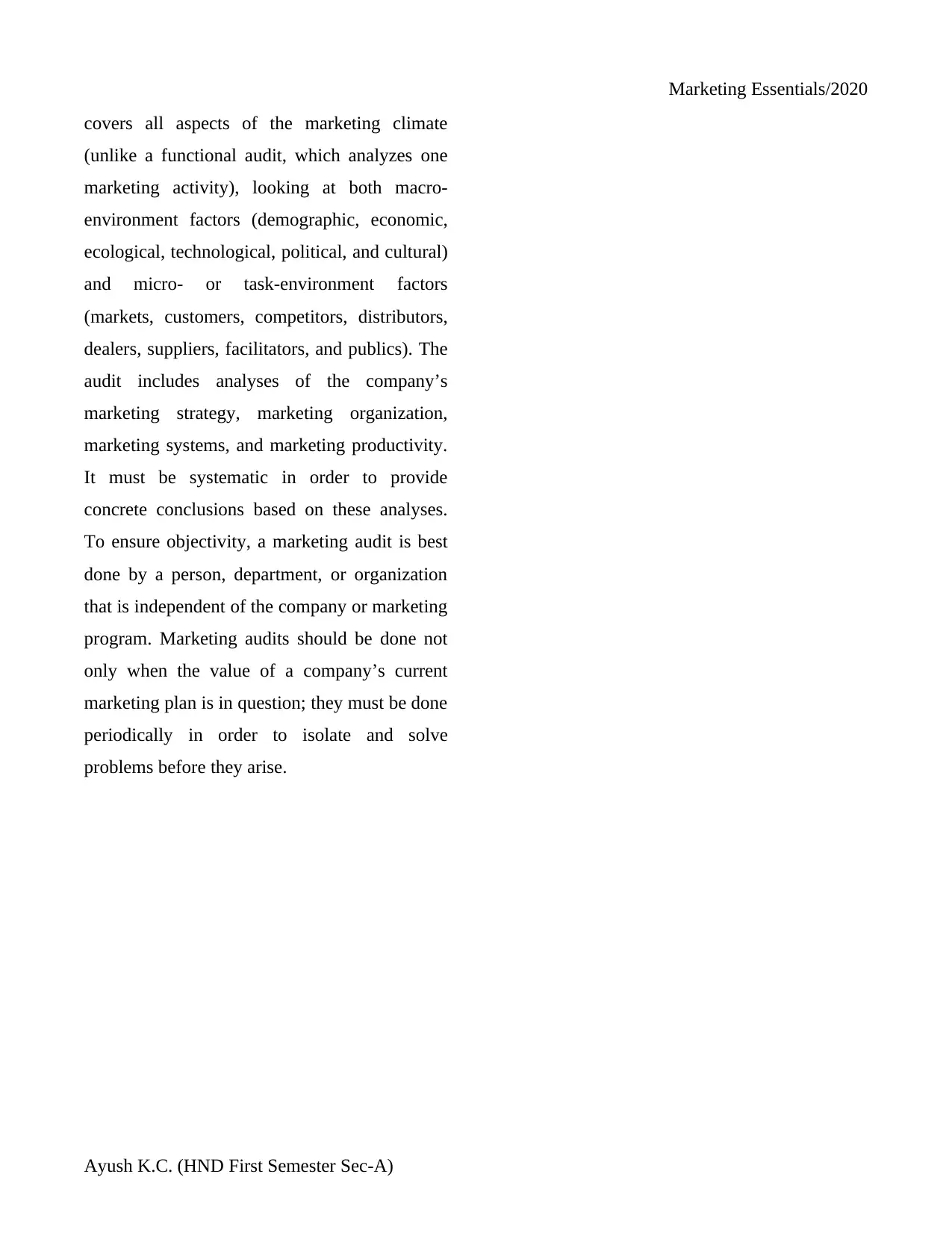
Marketing Essentials/2020
covers all aspects of the marketing climate
(unlike a functional audit, which analyzes one
marketing activity), looking at both macro-
environment factors (demographic, economic,
ecological, technological, political, and cultural)
and micro- or task-environment factors
(markets, customers, competitors, distributors,
dealers, suppliers, facilitators, and publics). The
audit includes analyses of the company’s
marketing strategy, marketing organization,
marketing systems, and marketing productivity.
It must be systematic in order to provide
concrete conclusions based on these analyses.
To ensure objectivity, a marketing audit is best
done by a person, department, or organization
that is independent of the company or marketing
program. Marketing audits should be done not
only when the value of a company’s current
marketing plan is in question; they must be done
periodically in order to isolate and solve
problems before they arise.
Ayush K.C. (HND First Semester Sec-A)
covers all aspects of the marketing climate
(unlike a functional audit, which analyzes one
marketing activity), looking at both macro-
environment factors (demographic, economic,
ecological, technological, political, and cultural)
and micro- or task-environment factors
(markets, customers, competitors, distributors,
dealers, suppliers, facilitators, and publics). The
audit includes analyses of the company’s
marketing strategy, marketing organization,
marketing systems, and marketing productivity.
It must be systematic in order to provide
concrete conclusions based on these analyses.
To ensure objectivity, a marketing audit is best
done by a person, department, or organization
that is independent of the company or marketing
program. Marketing audits should be done not
only when the value of a company’s current
marketing plan is in question; they must be done
periodically in order to isolate and solve
problems before they arise.
Ayush K.C. (HND First Semester Sec-A)
⊘ This is a preview!⊘
Do you want full access?
Subscribe today to unlock all pages.

Trusted by 1+ million students worldwide
1 out of 13
Related Documents
Your All-in-One AI-Powered Toolkit for Academic Success.
+13062052269
info@desklib.com
Available 24*7 on WhatsApp / Email
![[object Object]](/_next/static/media/star-bottom.7253800d.svg)
Unlock your academic potential
Copyright © 2020–2025 A2Z Services. All Rights Reserved. Developed and managed by ZUCOL.





